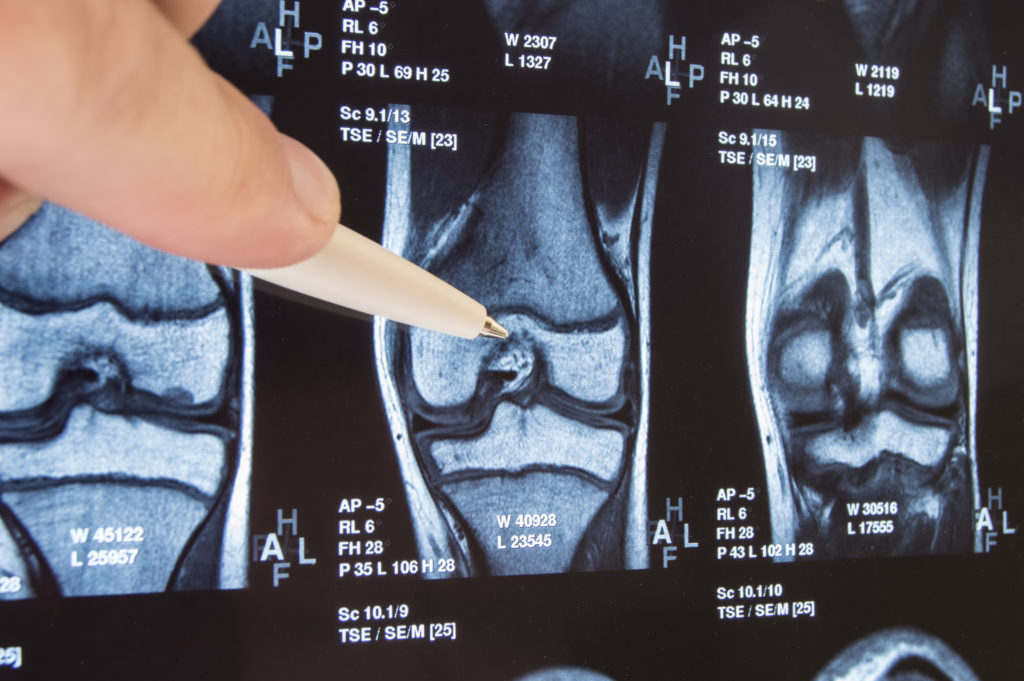THIS IS PART OF THE ULTIMATE GUIDE TO SPORTS MEDICINE
An ACL injury is a relatively common knee injury and is a sprain or tear in the anterior cruciate ligament.
Anatomy
Two bones meet to form your knee joint: your femur (upper leg bone) and tibia (lower leg bone). Your patella (kneecap) sits in front of the joint. Bones are connected to other bones by ligaments.
There are four primary ligaments in your knee: medial collateral ligament, anterior cruciate ligament, lateral collateral ligament and posterior cruciate ligament. They act like strong ropes to hold the bones together and keep your knee stable.
Cruciate ligaments are found inside your knee joint. By crossing each other they form an “X” with the anterior cruciate ligament in front and the posterior cruciate ligament in back. The cruciate ligaments control the back and forth motion of your knee.
The ACL runs diagonally in the middle of the knee. It prevents the tibia from sliding out in front of the femur and provides stability to the knee, both front to back and in rotation.
Other injuries in the knee can occur in conjunction with ACL injuries, such as damage to the articular cartilage, meniscus or other ligaments.
Most ACL injuries are complete tears. Partial ACL tears are more rare.
Types of ACL Sprains
- Grade 1 Sprains: The ligament is mildly damaged and slightly stretched, but is still able to help keep the knee joint stable.
- Grade 2 Sprains: The ligament is stretched to the point where it becomes loose, often referred to as a partial tear.
- Grade 3 Sprains: Referred to as a complete tear of the ligament; the ligament has been split into two pieces, and the knee joint is unstable.
ACL tear causes
Athletes who participate in sports such as soccer, football, basketball, volleyball and other high demand sports are more likely to tear their ACL. Other causes include:
- Sudden stopping and going
- Collision or direct contact resulting in a fall
- Changing direction rapidly
- Incorrectly landing a jump
ACL injury symptoms
- Swelling
- Pain
- Loss of full range of motion
- Discomfort when walking
- Tenderness
- Feeling of instability
Physician examination
To determine whether you have torn your ACL, your physician will ask you for a complete medical history, have you describe your symptoms and how the injury occurred, and conduct a physical examination. An X-ray or MRI may be necessary to confirm the diagnosis and determine if there are other problems.
OrthoIndy is proud to be the official orthopedic provider of the Indiana Pacers. Make an appointment with a knee specialist at OrthoIndy.
How do you treat an ACL tear?
There are generally three categories of individuals when determining the best course of treatment and recovery for an ACL injury.
- Copers: They generally have little or no symptoms for their ACL tear and return to their pre-injury lifestyle without limitations. They generally do well with physical therapy and don’t need surgery.
- Unstable only with athletic activity: These individuals will function well with daily activity, but their knee is unstable with running, jumping or pivoting. These individuals may choose surgery if they desire to return to athletic activities.
- Unstable all the time or ‘trick knee’: These individuals have instability and giving way with everyday tasks. These individuals almost always need surgery.
Treatment depends on the needs of the patient. Surgery is often necessary to return to sports and an active lifestyle; however, a less active individual may return to their lifestyle without surgery.
Most ACL tears cannot be stitched back together, instead the ligament must be reconstructed. Your physician will replace the torn ligament with a tissue graft that acts as a foundation for a new ligament to grow on. This is done arthroscopically using small incisions, which means less pain and a faster recovery time for the patient than in the past.
Rehabilitation
For the less active person who opts not to have surgery or someone who would rather just manage with the injury, physical therapy or bracing might be necessary to return to their lifestyle.
For all patients who choose surgery, physical therapy is very important. It focuses on reducing swelling and pain while returning motion to the joint and surrounding muscles. Later in the recovery process, focus is on regaining balance control and strengthening exercises. Complete rehabilitation is vital before making a full return to sport or repeat injury can occur.
Learn more about having knee pain treated at OrthoIndy.
Schedule an appointment
Your well-being is important to us. Click the button below or call us to schedule an appointment with one of our orthopedic specialists. If your injury or condition is recent, you can walk right into one of our OrthoIndy Urgent Care locations for immediate care. For rehabilitation and physical therapy, no referral is needed to see one of our physical therapists.





